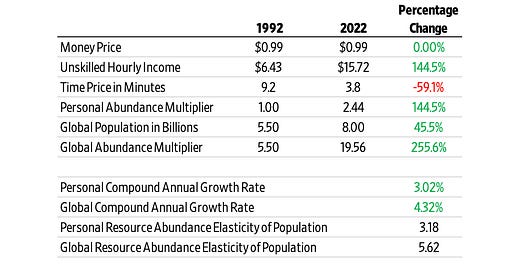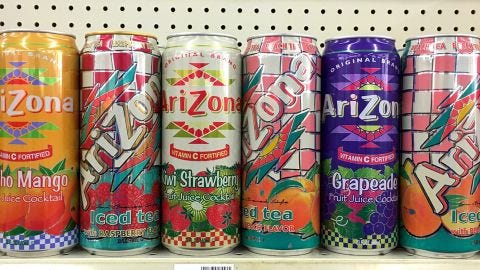AriZona Ice Tea Has Been 99 Cents For 30 Years
In the last 30 years, the tasty beverage has become 144 percent more abundant on a personal level and 256 percent more abundant on a global level.
AriZona Beverage began in New York City in the early 1990s under the inspiration of Don Vultaggio. The colorful 23 ounce cans have become icons. AriZona doesn’t advertise much. It relies on its creative design to attract attention. “We use packaging and a value story, then a great product inside,” Vultaggio said. “The first time a person buys us is because of the package. And forever more, they’re buying it because it tastes great.”
So how has the tasty beverage been able to hold its price constant with rising costs? While not being able to control input prices, Vultaggio looked for other ways to innovate. “We’ve done things behind the scenes…things I can control, like faster lines, automation, shipping using trains, light-weight boxes so you get more on a load, shipping at night. Those kind of things are what the consumer doesn’t see but that’s what I’ve been doing as a businessman for decades.” In other words continuously innovating to create value.
Innovation is the discovery and application of valuable new knowledge. We can measure this growth of knowledge with time prices. Innovation shows up both in lower prices and higher hourly incomes. The time price is the money price divided by hourly income. Money prices are expressed in dollars and cents while time prices are expressed in hours and minutes.
In 1992 unskilled workers were earning around $6.43 an hour. By 2022 the rate increased 144.5 percent to $15.72. At 99 cents, a can of AriZona ice tea cost 9.2 minutes in 1992, and fell 59.1 percent to 3.8 minutes in 2022. For the time it took unskilled workers to earn the money to buy one can in 1992, they would get 2.44 cans in 2022. The beverage has become 144.5 percent more abundant at a personal level over the last 30 years. This suggests abundance is growing at a compound annual rate of 3.02 percent.
Global resource abundance is equal to personal resource abundance multiplied by population. During the last 30 years global population has increased by 2.5 billion, or 45.5 percent, from 5.5 billion to 8 billion. We can say that the global abundance of AriZona ice tea has increased by 255.6 percent, growing at a 4.32 percent compound annual rate.
Elasticity in economics measures the change in one variable compared to another variable. Every one percent increase in global population corresponded to a 3.18 percent increase in ice tea abundance at the personal level and a 5.62 percent increase at the global level.
By continuously innovating to hold prices constant, the beverage competes with Costco’s $1.50 hot dog and soda combo introduced in 1985.
When you enjoy your refreshing beverage, thank Don Vultaggio and the millions of other entrepreneurs creating value for our planet each day.
P.S. You can buy AriZona Ice Tea at Walmart for only 88 cents ;)
If you find this article valuable, please share with a friend.
To get full access to all posts, you can subscribe for $5 a month or $50 a year.
You can log in to the website to read the full archives.
You can learn more about these economic facts and ideas in our new book, Superabundance, available at Amazon. Jordan Peterson calls it a “profoundly optimistic book.”
Gale Pooley is a Senior Fellow at the Discovery Institute and a board member at Human Progress.






